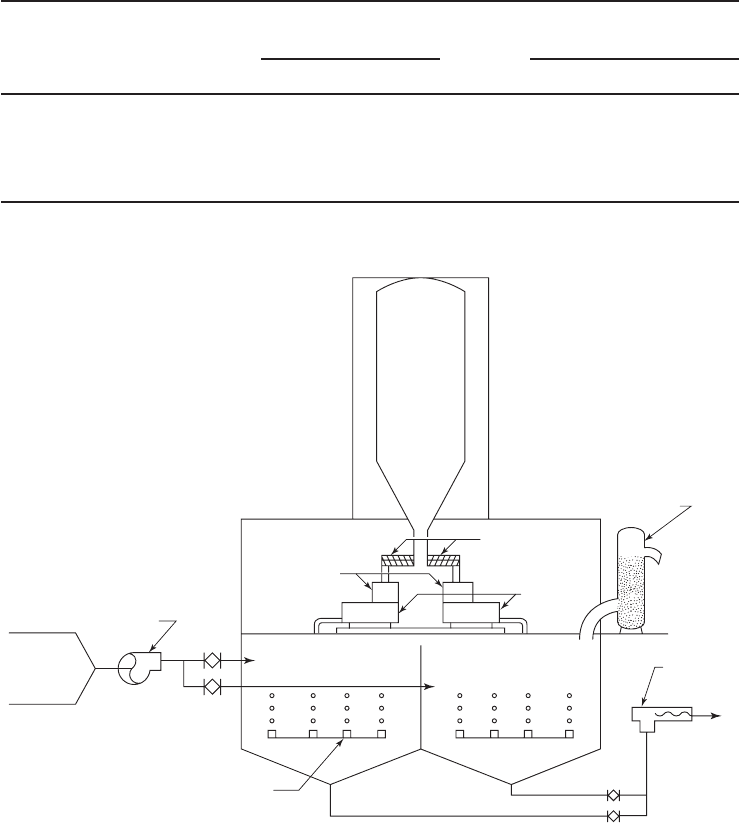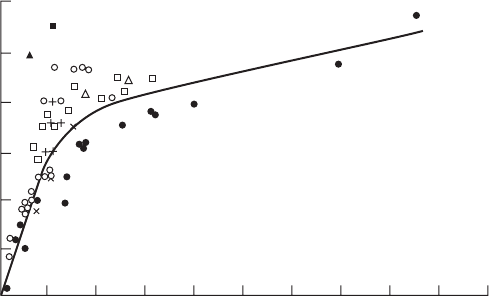Water and Wastewater Engineering
Подождите немного. Документ загружается.

WASTEWATER PLANT RESIDUALS MANAGEMENT 27-23
T ypical DAF performance in thickening of waste activated slud ge is in the range of 3.5 to
4.0 percent total solids with a capture efficiency in the range of 98 to 99 — plus percent. DAF
is generally not used for primary or trickling filter sludges because gravity thickening is more
economical (WEF, 1998).
27-7 ALKALINE STABILIZATION
The primary objectives of alkaline stabilization are to inhibit bacterial decom position of the
sludge and to inactivate pathogenic organisms. Quicklime and hydrated lime are the principle
alkaline compounds used. Others are cement kiln dust, lime kiln dust, and fly ash. Because lime is
the most widel
y used, it is the focus of this discussion. The application of other alkaline materials
is discussed in Metcalf & Eddy (2003) and WEF (1998).
Theory
The addition of a sufficient quantity of lime to untreated sludge raises the pH to 12 or higher.
The high pH substantially retards the microbial reactions that lead to odor production and vector
attraction. If the pH is maintained at this level, the sludge will not putrefy, create odors, or pose
a health hazard.
Chemical Reactions. Because of the heterogeneous nature of biological sl
udges, a large num-
ber of reactions can occur. Some examples of these are
Ca HCO CaO CaCO s HO
3
2
3 2
22
()
(27-4)
2633
3 42 2
PO H CaO Ca PO H O
4
3
()
(27-5)
CO CaO CaCO s
2 3
()
(27-6)
RCOOH CaO RCOOCaOH
(27-7)
Fat Ca OH glycerol fatty acids CaCO s() ()
2 3
(27-8)
Other reactions include hydrolysis of polymers, proteins, and amino acids. Many of these
reactions result in the production of off-gases, such as ammonia, that are odoriferous.
No direct reduction of organic matter occurs in lime treatment. If insufficient lime is added,
the resu
lt of these reactions will be a red uction in pH. If the pH drops below 11.0, biological
decomposition will resume and stabilization will then be inadequate.
Heat Generation. The addition of quicklime (CaO) to sludge results in a hydration reaction
with water. This reaction is exothermic with a heat release of approximately 64 kJ/g · mole. The
reaction with CO
2
is also exothermic with a heat release of approximately 180 kJ/g · mole.
27-24 WATER AND WASTEWATER ENGINEERING
Lime Pretreatment
The addition of lime to liquid sludge is called pretreatment. This method is used for direct land
application of liquid sludge or as conditioning prior to dewatering. Lime pretreatment requires
more lime per unit weight of sludge processed than is necessary for dewatering. This is beca
use
the chemical demand of the liquid requires a higher dose to achieve the required pH for disposi-
tion on land.
Lime Posttreatment
The addition of lime with dewatered sludge in a pug mill, paddle mixer, or screw conveyor is
called posttreatment. E xcellent mixing is required to ensure contact between partic les of s lu d ge
and lime and to avoid pockets of putrescible material. When well mixed, the stabilized product i
s
a crumbly mixture that can be stored for long periods.
Alkaline Stabilization Design Practice
The d esign objective is to meet the regulatory requirements specified in the Code of Federal
Regulations (40 CFR Part 503). These are outlined in Chapter 18. To meet Class A criteria, suf-
ficient alkali must be added to maintain the pH above 12 for more than 72 hours to ensure patho-
gen destruction. The temperature must be above 52 C for at least 12 hour
s during the period the
pH is greater than 12. The solids must be air dried to over 50 percent after the 72-hour period at
elevated temperature.
To meet Class B requirements and to reduce vector attraction, sufficient alkali must be
added to raise the pH to at least 12 for two hours at 25 C and maintain a pH of 11.5 for 22 more
hours (40 CFR 503.
33(b)(6)). In theory, this should provide enough residual alkalinity s o that
the pH does not drop below 11 for several days. The recommended design criteria are (U.S.
EPA, 1979):
• Treat the sludge in a liquid state.
• Bring the sludge to a pH of 12.5 by lime addition and maintain the pH above 12.5 for
30 minutes. This keeps the pH above 12 for two hour
s.
The amount of lime required is determined by the type of sludge, its chemical composition,
and the solids concentration. Example lime dosages are given in Table 27-9 . For specific applica-
tions testing must be performed to determine the actual do
sage requirements.
A conceptual lay out for a lime stabilization facility is shown in Figure 27-10 . The mixing
tank is typically designed to operate in a batch process mode. The volume of the tank must be
large enough to hold the sludge for 30 minutes. The holding capacity may be c
onsiderably larger,
depending on the plant operating mode and shift responsibilities for treating the sludge. For a
Class A sludge, additional storage volume beyond the mixing tank must be provided to meet the
temperature and time requirements (52 C for 12 hours).
Mixing may be either by air or by mec
hanical mixers. For air mixing, coarse bubble
diffusers are m ounted along one wall of the tank to create a spiral roll. The air supply should be

WASTEWATER PLANT RESIDUALS MANAGEMENT 27-25
Grinder
Mixing tank 1 Mixing tank 2
Progressing
cavity pump
To dewatering
equipment
Slakers
Augers
Odor control unit
Quicklime
storage
silo
Volumetric
feeders
Primary
Waste-
Coarse air
bubble diffusers
activated
sludge
sludge
FIGURE 27-10
Conceptual design for a lime stabilization facility.
( Source: U.S. EPA, 1979.)
TABLE 27-9
Example lime dosages for pretreatment sludge stabilization at Lebanon, OH
Solids
concentration, %
Lime dosage,
g Ca(OH)
2
/kg dry solids
Type of sludge Range Average Range Average
Primary 3–6 4.3 60–170 120
Waste activated 1–1.5 1.3 210–430 300
Anaerobically
digested mixed 6–7 5.5 140–250 190
NOTE: lime requirement to keep pH at 12 for 30 minutes.
A dapted from U.S. EPA, 1979.
rated at 20 m
3
/ min · 1,000 m
3
of tank volume. For mec hanical mixing, the bulk fluid velocity
(turbine agitator pumping capacity divided by the cross-sectional area) should be greater than
8.5 m/min, and the impeller Reynolds number should be greater than 1,000 (U.S. EPA, 1975).
Some examples are shown in Table 27-10 .

27-26 WATER AND WASTEWATER ENGINEERING
Example 27-3. Design a pretreatment lime stabilization system for Omega Three (Example 27-2).
Determine the volume of the reactor tank, mixer size (kW, rpm, turbine diameter), lime feed rate,
and lime storage volume for two-week delivery. Assume the specific gravity of the sludge is 1.012,
that lime has a bulk density of 640 kg/m
3
, and that a 14-day supply will be stored.
Solution:
a . From Example 27-2, the volume of sludge delivered per shift is 90 m
3
. From Table 27-10 ,
a standard tank that will hold this volume is 115 m
3
.
b. From Table 27-10 , select a mixer with the following characteristics: 2.1 m turbine,
14.5 kW motor, and shaft speed of 37 rpm.
c. The mass of dry solids is determined using Equation 15-9. From Example 27-2, the %
solids is 3.8 and the volume of the slud
ge per pumping cycle is 90 m
3
.
Nominal
tank size, m
3
Tank
diameter, m
Turbine
diameter, m
Motor
size, kW
Shaft
speed, rpm
20 2.9 0.82 5.6 125
0.98 3.7 84
1.1 2.2 56
60 4.2 1.1 14.9 100
1.3 11.2 68
1.6 7.5 45
1.7 5.6 37
1155.2 1.5 3084
1.6 22.4 68
1.7 18.6 57
2.1 14.5 37
280 7.1 1.6 74.5 100
1.9 55.9 68
2.0 44.7 56
2.2 37.2 45
380 7.8 1.8 93.2 84
2.0 74.5 68
2.4 55.9 45
TABLE 27-10
Mechanical mixer specifications for sludge slurries
A ssumptions:
B ulk fluid velocity 8.5 m/min
I mpeller Reynolds number 1,000
Liquid depth equals tank diameter
Baffles with a width of 1/12 tank diameter placed at 90 degrees
Freeboard of 0.6 m added to liquid depth
A dapted from U.S. EPA (1975).

WASTEWATER PLANT RESIDUALS MANAGEMENT 27-27
V
M
SP
M
sl
s
sl s
s
()( )( )
()( )(
90 1 000 1
3
m kg/m
3
,..012 .038
,
)( )0
3 461 or 3,500 kg per pumping cycle.
d. The mass of lime (CaO) for each batch is the ratio of the gram molecular weights for the
slaking of lime. From the reaction shown below, one mole of CaO reacts with water to
produce one mole of hydrated lime (Ca(OH)
2
).
CaO H O Ca OH
22
()
e. From Table 27-9 , assume a dose of 300 g Ca(OH)
2
/kg dry solids for WAS. The mass of
lime (CaO) for each batch is then
GMW CaO
GMW Ca OH
g/kg)(3,461 kg)(10
3
()
(
2
300
kg/g)
g/kg)(3 461 kg)(10 kg/g)
3
56
74
300(,
()( )076 103 8 3 785 7., .. or 790 kg per batch
f. The lime feed rate is set to match the flow rate of the sludge. The lime feed rate is then
785 7
60
.kgperbatch
delivery per batchmin
113 1. kg/min
g. The volume of the lime storage silo is
V ()( )(3 785 71batches per day kg per batch.44 1 640
51 56 52
3
3
d supply / kg/m
or m
)( )
.
Comment. For practical, operational use, the specific gravity of sludge is often taken to be 1.0.
27-8 AEROBIC DIGESTION
Process Description
The aerobic digestion of biological sludges is a continuation of the activated sludge process.
When a culture of aerobic heterotrophs is placed in an environment containing a source of organic
material, the microorganisms remove and utilize most of this material. A fraction of the organic
material removed will be used for the
synthesis of new biomass. The remaining material will
be channeled into energy metabolism and oxidized to carbon dioxide, water, and soluble inert
material to provide energy for both synthesis and maintenance (life-support) functions. Once
the external source of organic material is exhausted, however, the mi
croorganisms enter into
endogenous respiration, where cellular material is oxidized to satisfy the energy of maintenance
(that is, energy for life-support requirem ents). If this condition is continued over an extend ed
period of time, the total quantity of biomass will be considerably reduced. Further
more, that
27-28 WATER AND WASTEWATER ENGINEERING
portion remaining will exist at such a low energy state that it can be considered biologically
stable and suitable for disposal in the environment. This forms the basic principle of aerobic
digestion.
Three aerobic stabilization processes are in common use: conventional aerobic digestion,
high-purity oxygen aerobic digestion, and au
tothermal aerobic digestion (ATAD). Of these three,
conventional aerobic digestion is the most common. This discussion is limited to conventional
aerobic digestion.
Theory
A ssuming the formula C
5
H
7
NO
2
i s representative of cell mass, the biochemical changes in an
aerobic digester may be described by the following equations (Metcalf & Eddy, 2003):
Biomass destruction:
CHNO O CO HO NHHCO
5 72 2 2 2 4 3
5 4
(27-9)
Nitrification of released ammonia:
NH O NO H H O
4 3
22
22
(27-10)
Overall equation with complete nitrification:
C H NO O CO H O HNO
5 72 2 2 2 3
7 5 3
(27-11)
U sing nitrate as an electron acceptor (denitrification):
C H NO NO H O NH HCO NO
3 4 35 72 2 2
4 5 3 5 2
(27-12)
With complete nitrification/denitrification:
2115 10 7
5 72 2 2 2 2
CHNO O CO HO N.
(27-13)
The conversion of organic nitrogen to nitrate results in a decrease in pH (Equations 27-9
through 27-11). Approximately 7 kg of CaCO
3
alkalinity are consumed for each kg of ammonia
oxidized. If the dissolved oxygen concentration is kept below 1 mg/L, denitrification will occur.
Theoretically , 50 percent of the alkalinity can be rec overed. Cycling between aeration and
mechanical mixing can be used to increase denitrification while maintaining pH control.
When there is insufficient b
uffering capacity to hold the pH above 5.5, lime, sodium
bicarbonate, or sodium carbonate will have to be added.
Aerobic Digestion Design Practice
A s with alkaline stabilization, the design objective is to meet the regulatory requirements specified
in the Code of Federal Regulations (40 CFR Part 503). These are outlined in Chapter 18. The
processes to meet the Class B criteria to significantly reduce pathogens (PSRP) and to reduce
vector attraction serve as a basis for this d
iscussion of design practice. These may be summarized
as agitation of biosolids with air or oxygen to maintain aerobic conditions for a solids retention
time (SRT) and temperature between 40 d at 20 C and 60 d at 15 C (40 CFR 503.33(b)). There are

WASTEWATER PLANT RESIDUALS MANAGEMENT 27-29
several options given to verify that a significant reduction in pathogens and reduction of vector
attraction have been achieved. Among the options to reduce vector attraction, the following are
particularly applicable to the discussion of design practice. They require
• A 38 percent reduction in volatile solids by aerobic digestion, or
• Specific bench sc
ale testing for volatile solids reduction, or
• A specific oxygen utilization rate (SOUR) at 20 C of 1.5 mg of oxygen/h · g total solids.
The influence of these requirements on the design of aerobic digesters is discussed in the
following paragraphs under the headings of temperature, volatile solids reduction, tank volu
me,
feed solids concentration, oxygen requirements, and energy requirements for mixing.
Temperature. As with all biological systems, lower temperatures will retard the biochemical
processes. High temperatures lower the saturation value of dissolved oxygen in water and thus
require an increa
se in the supply of air. Temperature boundary conditions for design require that
the degree of sludge stabilization be determined at the lowest expected liquid operating tempera-
ture and that the maximum oxygen requirements be determined at the highest liquid operating
temperature.
Volatile Solids Reduction. Approxi
mately 20 to 35 percent of waste activated sludge from
plants with primary treatment is not biodegradable. Thus, the goal of 38 percent reduction in
volatile solid s is a reasonable one. Both the liquid temperature and SRT control the degree of
solids reduction. A plot of degree-days (temperature times SRT) versus volatile solids
reduction
( Figure 27-11 ) reveals that 38 percent reduction can be achieved above approximately 400
degree-days. To produce well-stabilized biosolids, at least 550 degree-days are recommended.
0
0
10
20
3
0
Perce
nt
volatile solids reduction
40
5
0
6
0
200 400 600 800 1,000 1,200 1,400 1,600 1,800 2,000
Temperature C sludge age, days
FIGURE 27-11
Volatile solids reduction as a function of digester liquid temperature and digester
sludge age.
( Source: U.S. EPA, 1979.)

27-30 WATER AND WASTEWATER ENGINEERING
Tank Volume. The volume of the digester tank may be estimated with the following equation
(WEF, 1998):
QX F
XkP SRT
i
dv
()
()
PS
1/
V
(27-14)
where
volume
V
of aerobic digester, m
3
Q average flowrate to digester, m
3
/ d
X
i
influent suspended solids, mg/L
F
PS
fraction of influent BOD that is raw primary solids
S digester influent BOD, mg/L
X digester suspended solids, mg/L
k
d
reaction rate constant, d
1
P
v
volatile fraction of digester suspended solids
SRT solids retention time, d
The term F
PS
can be ignored if primary sludge is not included in the sludge load to the digester.
Representative values for k
d
range linearly from 0.02 d
1
at 10 C to 0.14 d
1
at 25 C for waste
activated sludge (U.S. EPA, 1979). Bench-scale or pilot-scale studies are recommended to obtain
site-specific decay coefficients.
Feed Solids Concentration. Thickening prior to aerobic digestion provides the following
advantages: longer SRTs, smaller digester volume, easier process control, higher ox
ygen input per
unit volume, and increased levels of volatile solids destruction. However, feed solids concentrations
greater than 3.5 to 4 percent will impede mixing and adequate dissolved oxygen levels (Metcalf &
Eddy, 2003). Solids concentrations greater than 4 percent are not recommended
.
Oxygen Requirements. The oxygen concentration in the digester should be maintained at
1 mg/L. The m ass of oxygen required for complete oxidation of cell tissue and nitrification
is about 2.3 kg/kg of cells. Oxidation of the BOD in primary sludge varies from 1.6 to 1.9 kg of
oxygen/kg of BOD oxidized (Metcalf & Eddy, 2003).
Energy for Mixing.
Coarse bubble diffusers are recommended. Plugging is a problem with
either coarse or fine bubble diffusers. This is especially the case when periodic settling is used
so supernatant can be removed. Air flow rates between 0.02 and 0.04 m
3
of air/min · m
3
of liquid
volume ensure adequate mixing. The amount of air required to maintain the DO level usually
exceeds this flow rate. Diffused aeration has advantages over mechanical mixing in cold climates
because the compressed air adds heat to the s ystem, and overall heat loss is less
because of a
smaller degree of surface disturbance.
Mechanical aerators are sized at 20 to 40 kW/10
3
m
3
of liquid volume. Submerged turbines
and jet aerators have also been used for mixing and aeration.
Mixing is difficult for concentrations greater than 3.5 percent. If polymers are used in the
thickening process, a greater amount of unit energy may be required for mixing.
Supernatant. The supernatant is returned
to the head end of the plant. The aerobic digestion
process produces a low-strength supernatant ( Table 27-11 ). The true loading from the supernatant
is not the total BOD
5
b ut the filtered BOD
5
because the solids are in the endogenous stage of
respiration. In addition, the flow rate is generally less than 1 percent of the influent plant flow.

WASTEWATER PLANT RESIDUALS MANAGEMENT 27-31
Dewatering. The literature addressing dewatering of aerobically digested sludge is contradic-
tory. Good results can be obtained with sand drying beds. Mixed results with mechanical devices
leads to the recommendation to conduct a thorough on-site investigation with pilot-sc
ale devices.
Interviews and site visits at other facilities employing these devices for aerobic sludge dewater-
ing is also advisable.
Aerobic Digestion Design Criteria. Typical design c riteria are summarized in Table 27-12 .
An example design follows the table.
Parameter Range, mg/L Typical, mg/L
BOD
5
9–1,700 500
Filtered BOD
5
4–183 50
COD 288–8,140 2,600
Kjeldahl nitrogen 10–400 170
Nitrate-N N/A 30
Total P 19–241 100
Soluble P 2.5–64 25
Suspended solids 46–11,500 3,400
TABLE 27-11
Characteristics of supernatant from aerobic digestion
systems
A dapted from WEF, 1998.
Parameter Range of values
Feed concentration 1.5–3.5%
SRT to meet PSRP
a
At 15C 60 d
At 20C 40 d
k
d
at 10C
0.02 d
1
k
d
at 15C
0.06 d
1
k
d
at 20C
0.10 d
1
k
d
at 25C
0.14 d
1
Volatile solids loading 1.6–4.8 kg/m
3
· d
Oxygen requirements:
Cell tissue 2.3 kg O
2
/kg VSS destroyed
BOD
5
in primary sludge 1.6–1.9 kg O
2
/kg VSS destroyed
Oxygen concentration 1 mg/L
Air flow rates for oxygen
Waste activated sludge (WAS) 0.015–0.020 m
3
/min · m
3
Mixed primary and WAS 0.024–0.030 m
3
/min · m
3
TABLE 27-12
Typical design criteria for aerobic digesters
(continued)

27-32 WATER AND WASTEWATER ENGINEERING
Example 27-4. An aerobic digester for Omega Three (Examples 27-2 and 27-3) is being con-
sidered as an alternative to alkaline stabilization. Determine the volume of the digester and the
required air flow rate to meet a Class B pathogen density (PSRP). The following data have been
obtained for this analysis:
Winter conditions govern
T e mperature of digester contents 15 C
VSS 0.8 TSS
VSS re
duction goal 40%
Influent BOD 5,200 mg/L
Fraction of influent BOD consisting of primary solids 0.35
Digester suspended solids concentration is 70% of the incoming thickened sludge concentration
Diffused air mixing is to be used
Solution:
a . Check the requ
irements for volatile solid s reduction and the SRT to meet PSRP (See
Chapter 18). Find that the product of temperature and sludge age from Figure 27-11 at
40% VSS is 500 C · d. At a temperature of 15 C,
SRT
C d
C
d
500
15
33 33.
This is less than the PSRP requirement for an SRT of 60 d at a temperature of 15 C, so
the 60 d SRT governs (See Table 18-15).
b. Using Equation 27-14, compute the volume of the digester. Note from Example 27-2
that the influent concentration is 3.8% or 38,000 g/m
3
and that X (38,000) (0.7).
Parameter Range of values
Mixing requirements
Mechanical aerators/mixers 20–40 kW/10
3
m
3
Diffused air mixing 0.02–0.040 m
3
/min · m
3
Reduction in VSS 38–50%
Tank dimensions
Depth for diffused air 4.5–7.5 m
Depth for mechanical air 3–6 m
Circular diameter
b
12–45 m
Rectangular
W:D 1:1 to 2.2:1
L:W 5:1
TABLE 27-12 (continued)
Typical design criteria for aerobic digesters
a
PSRP process to significantly reduce pathogens.
b
Circular is the typical configuration.
Sources: 40 CFR 503; Metcalf & Eddy, 2003; U.S. EPA, 1979; WEF, 1998.
